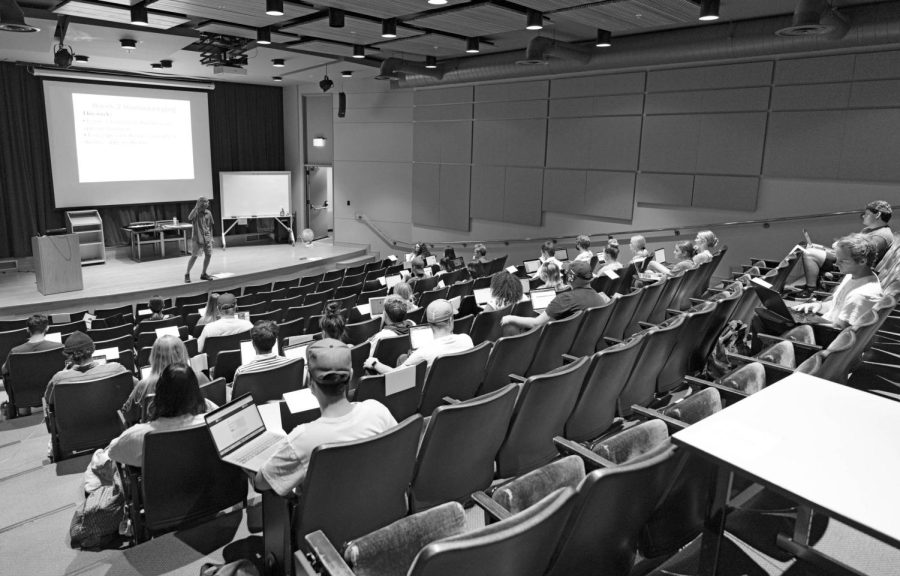Hibben: In-Person Learning Isn’t a Cure-All
(Photo by Kevin Cody | The Daily Utah Chronicle)
September 30, 2021
As the University of Utah opens up more for in-person classes, old stressors have reappeared.
Since March 2020, rates of anxiety or depression have skyrocketed in adults. But this issue existed even before the pandemic. College students have reported similar rates for years, and trends have shown that anxiety has become a common mental health issue that students suffer from.
From 2008 to 2016, more than 60% of college students reported experiencing symptoms of anxiety, and there was a 92% increase in female students suffering from some type of anxiety disorder.
In-person learning will not solve students’ anxiety about school. Returning to in-person learning demonstrates a misunderstanding of the need for mental health considerations that the pandemic brought to light.
Some students and professors thrive with elements of both in-person and online. The university and professors should make a transition to “hybrid learning” to work with students’ preferences to create accessible courses.
COVID-19 Concerns
On top of regular stressors that come with in-person learning, the pandemic still looms over students’ heads. New concerns over the delta variant and the CDC’s current advice to wear masks regardless of vaccination status raise anxiety levels. Before the U implemented their COVID-19 vaccine mandate, students felt anxious about going to class.
I spoke with Abby Duzy, a student at the U, who said “I find it’s hard for me to pay attention … it also kind of limits who I interact with in class.”
Even with a vaccine mandate, the future of the pandemic remains uncertain. This unknown future students face during this strange semester places a burden on their mental health and their ability to learn properly.
For students who are immunocompromised or have family members that are at risk, the choice between education and health shouldn’t be a decision they’re forced to make.
Test Anxiety and Presentations
Along with pandemic stressors comes the anxieties of pre-pandemic classes — specifically exams and presentations. Duzy said, “Test anxiety is definitely something that’s come back up like almost immediately,” even during the first week of school.
For someone with anxiety, an in-person test surrounded by their peers in an eerily quiet lecture hall can be a difficult environment to focus in.
Students can experience physical symptoms, including panic attacks or difficulty breathing, as well as cognitive and emotional symptoms. Students with anxiety have protested against presentations, saying that forcing students to be uncomfortable is wrong.
Cold-calling, a staple practice in law school, has been criticized for promoting fear and anxiety in an already stressful environment. Making a mistake in public can feel overwhelming to someone with anxiety, and requiring students to push past their own comfort levels contradicts the emphasis that universities have started to place on mental health.
Letting students choose at-home testing options or substitute assignments opens up conversations around campus that stress the importance of mental health over strict standards.
Solutions
Online learning had some positive outcomes. Duzy noted her grades were better and that she could avoid awkward introductions that made her anxious. Online courses helped students who didn’t have the time to attend in-person classes to get an education and opened up new possibilities.
Beyond mental health, issues such as the ever-stressful parking and traffic situation have returned to most student’s top complaints. As online learning increases in classrooms worldwide, universities can’t simply ignore the positive side of that learning environment.
We should encourage hybrid methods of learning, which combine aspects of both online and in-person learning. New technologies are being created to help tackle some of the gaps that online learning had before, and some reports have shown that online students learn the same amount as in-person students.
A complete shift back to “normal” is a backward step towards addressing students’ mental health in school. Greater flexibility while still providing face-to-face teaching will likely become our new future — not returning to traditional modes of learning.
During the pandemic, universities and workplaces have started to stress the importance of mental health and the mental well-being of their students. However, elements of in-person learning reverse some of the progress being made.
Professors and administrators at the U should become more aware and concerned about these stressors. Students should be given a choice in the learning environment they feel more confident to succeed in. Advocating for mental health in classrooms and on campus by offering these choices can help students adapt to this “new normal.”









